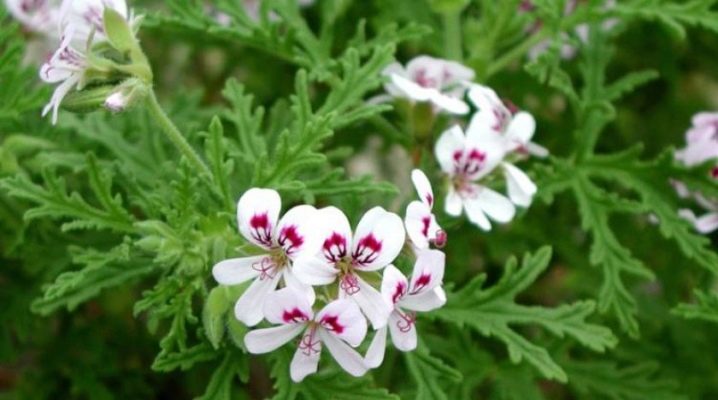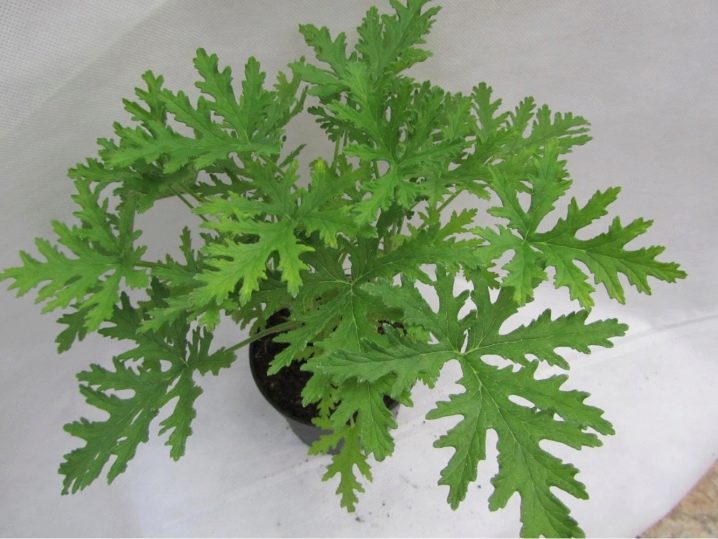Geranium (pelargonium) lemon: features and rules of care

Lemon geranium is a type of scented pelargonium. It is a fairly tall plant, with heart-shaped leaves with sharp tips and a strong citrus aroma. Most often, it can be found on window sills in flowerpots or containers, this plant, at the slightest contact, emits a persistent lemon smell and perfectly refreshes the air in the apartment.

Description
Lemon geranium is a bush with a height of about 70 centimeters, however, its width is no more than 35 centimeters. The plant cannot boast of frequent and abundant flowering, however, it does not need it. The attractive appearance and delicate scent of lemon is appreciated by many flower growers. Bright green, strong stems radiate from the woody base.
The leaves are very beautifully shaped, carved, curved, with a frame resembling lace. Their shades can range from rich to light green, in some cases cream, burgundy and purple tones appear. If geranium still bloomed, which is often facilitated by competent care, it pleases its owner with small (about 2 centimeters) light flowers that grow both singly and in inflorescences.

Landing
Lemon geranium is not a demanding plant. The best option for this indoor flower will be a spacious room where there will be enough light. Experts talk about the beneficial properties of pelargonium, for example, its aroma can improve a person's sleep, so the location in the bedroom will be an advantage. Also, a flower will be useful in the kitchen, because it is able to cleanse the air of microbes and rid the room of unpleasant odors.
If there are children suffering from allergic reactions in the room, it is better not to place this plant in it.
Geranium can also be placed outside in the summer, however, in this case, it is required to protect it from direct sunlight.



As for the planting procedure itself, the choice of container is important. The flowerpot should be quite voluminous, since the plant cannot stand tightness and, if there is not enough space, it may simply die. In addition, you should observe the lighting standards and choose the right soil.

Lighting and location
Geranium is a flower that loves light very much. However, placing it in partial shade and in the depths of the room will not be a particular problem either. In addition, if the lighting is not enough, you can immediately understand this by the appearance of the plant. The leaves will become much lighter, the plant will stretch in height. When these signs appear, lemon geraniums should simply be placed in the sun for several hours once a day. Without enough light, pelargonium will not bloom.
In terms of location, the east or west side of the house is ideal. The best option is to place the flower on the windowsill.
However, it should be borne in mind that he is afraid of drafts, so they should be excluded as much as possible. Placing near a battery or under an air conditioner is also not a good idea.

The soil
To make pelargonium feel comfortable, it is recommended to place it in a container with special soil. In its absence, a universal option is suitable. The soil can be prepared independently or purchased at a specialized outlet. Basic requirements: the presence of a drainage layer, sufficient looseness, the presence of mineral elements.
To make a suitable soil on your own, you will need river sand, charcoal, humus, peat, turf soil. All of these components should be used in equal proportions. Another indicator that needs to be monitored is the level of acidity. It should be around 6.5 pH.
The best option is slightly acidic or neutral soil, which will need to be loosened periodically in order for the root system to be provided with oxygen.

Home care
Lemon geranium grows well and develops at home. In order for the plant to be comfortable, some recommendations should be followed. The optimum air temperature is about 20 degrees. The plant loves moisture and needs regular watering, in summer the procedure should be carried out daily, in winter it should be reduced to a couple of times a week. The main thing is to control the absence of stagnant water and excess liquid. Do not spray geraniums, this can lead to the appearance of light yellow spots, which significantly spoil the appearance.
The plant needs fresh air, so if possible it is recommended to ventilate the room, however, it is necessary to exclude the possibility of drafts. Geraniums require an annual transplant, it is best to carry it out at the very beginning of spring. Pruning is also done in the spring, but pinching is done in the fall.
It should be borne in mind that during the flowering period, the lemon scent will become much weaker. To prevent this, you can carefully remove the buds from the bush.

For feeding, it is best to use special means. Mister Color and Gilea are perfect. Before using them, you must carefully read the instructions. You need to fertilize the flower in spring and autumn. Do not use cold water for irrigation. It must be clean, filtered or settled.
The recommended water temperature is +30 degrees.

Diseases and pests
Despite the fact that geranium is a plant that is resistant to the development of diseases, in some cases they are able to infect it. You can notice a nuisance by the appearance of the flower, discoloration, twisted leaves, and other factors. Most often, this is due to a violation of the basic rules of care.
Among the moments that should alert the grower, one cannot fail to note the wilting of greenery, rotting of the roots, the appearance of spots on the leaves, the absence of flowering for a long time. Most often, a simple change in flower care helps, however, there are also more serious cases.

For diseases such as gray mold, sometimes found in geraniums, antifungal drugs should be used. Before using them, you should remove the damaged parts of the plant. In the presence of infectious diseases, fungicides will be excellent.
Insect infestations are not typical for lemon geraniums. They are frightened off by the pungent smell of the plant. However, sometimes white flies and aphids can be seen on the leaves. In this case, you should treat the plant with soapy water or apply insecticides.


Healing properties
Lemon geranium can also be used according to its medicinal properties. After consulting a doctor, the plant can be used for diseases such as otitis media, ENT diseases, epilepsy, colds, headaches, sleep disturbances. In some cases, the plant can serve as an antiseptic. It is used to stop bleeding and speed up wound healing. Also, one cannot fail to note the deodorizing properties of geranium.



See below for more details.







































































































The comment was sent successfully.